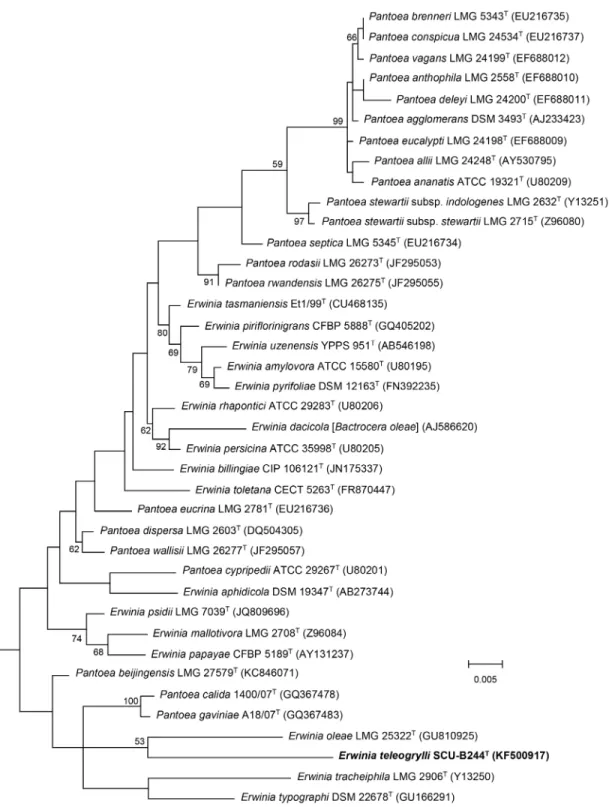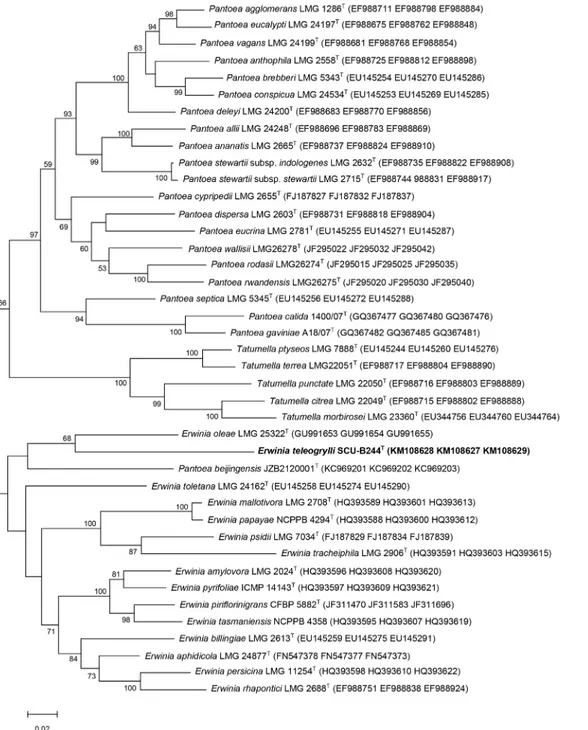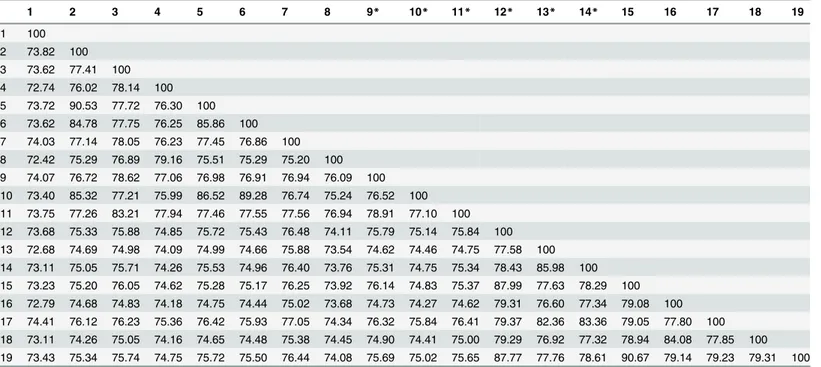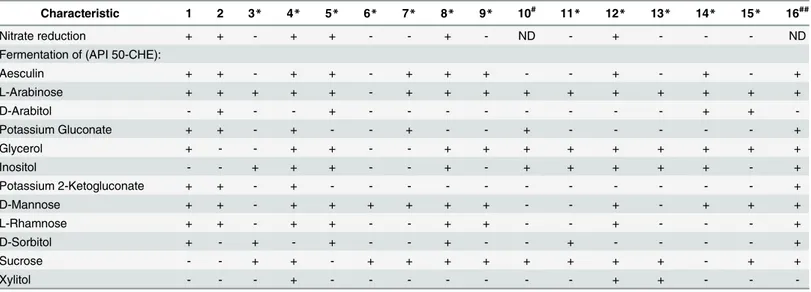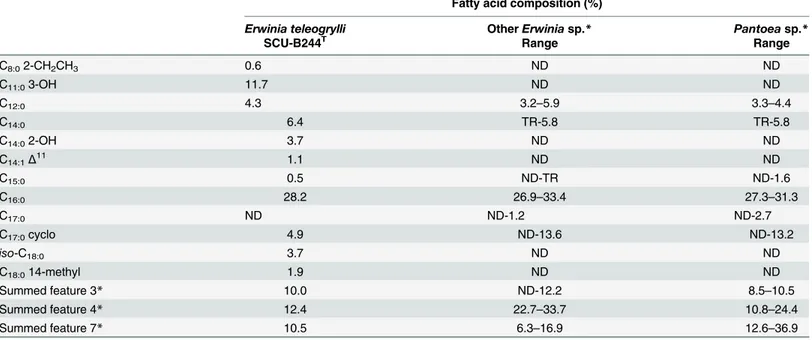Erwinia teleogrylli
sp. nov., a Bacterial Isolate
Associated with a Chinese Cricket
Bo Liu1,2¤, Jin Luo2, Wei Li2, Xiu-Feng Long1, Yu-Qin Zhang3, Zhi-Gang Zeng4,
Yong-Qiang Tian1*
1Key laboratory of Leather Chemistry and engineering, College of Light Industry, Textile & Food Engineering, Sichuan University, Chengdu, Sichuan, P. R. China,2Department of Pharmaceutical and Biological Engineering, College of Chemical Engineering, Sichuan University, Chengdu, Sichuan, P. R. China,3Institute of Medicinal Biotechnology, Chinese Academy of Medical Sciences & Peking Union Medical College, Beijing, P. R. China,4Sichuan Industrial Institute of Antibiotics, Chengdu University, Chengdu, Sichuan, P. R. China
¤ Current address: Institute of Microbiology, Chinese Academy of Sciences, Beijing, P. R. China
*yqtian@scu.edu.cn
Abstract
A bacterial isolate (SCU-B244T) was obtained in China from crickets (Teleogryllus occipita-lis) living in cropland deserted for approximately 10 years. The isolated bacteria were Gram-negative, facultatively anaerobic, oxidase-negative rods. A preliminary analysis of the 16S rRNA gene sequence indicated that the strain belongs to either the genusErwiniaor Pan-toea. Analysis of multilocus sequence typing based on concatenated partialatpD,gyrBand infBgene sequences and physiological and biochemical characteristics indicated that the strain belonged to the genusErwinia, as member of a new species as it was distinct from other knownErwiniaspecies. Further analysis of the 16S rRNA gene showed SCU-B244T to have 94.71% identity to the closest species of that genus,Erwinia oleae(DSM 23398T), which is below the threshold of 97% used to discriminate bacterial species. DNA-DNA hybridization results (5.78±2.52%) between SCU-B244TandErwinia oleae(DSM 23398T) confirmed that SCU-B244TandErwinia oleae(DSM 23398T) represent different species combined with average nucleotide identity values which range from 72.42% to 74.41. The DNA G+C content of SCU-B244Twas 55.32 mol%, which also differs from that ofErwinia oleae(54.7 to 54.9 mol%). The polyphasic taxonomic approach used here confirmed that the strain belongs to theErwiniagroup and represents a novel species. The nameErwinia teleogryllisp. nov. is proposed for this novel taxon, for which the type strain is SCU-B244T (= CGMCC 1.12772T= DSM 28222T= KCTC 42022T).
Introduction
Resistance to pesticides in insects is a serious concern worldwide [1] and often occurs approxi-mately 10 years after the introduction of a new pesticide [2]. The resistance mechanisms have been attributed to evolutionary changes in insect genomes, such as the alteration of drug target sites, up-regulation of degrading enzymes and the enhancement of drug excretion. Kikuchi a11111
OPEN ACCESS
Citation:Liu B, Luo J, Li W, Long X-F, Zhang Y-Q, Zeng Z-G, et al. (2016)Erwinia teleogryllisp. nov., a Bacterial Isolate Associated with a Chinese Cricket. PLoS ONE 11(1): e0146596. doi:10.1371/journal. pone.0146596
Editor:Olga Cristina Pastor Nunes, University of Porto, PORTUGAL
Received:May 11, 2015
Accepted:December 18, 2015
Published:January 22, 2016
Copyright:© 2016 Liu et al. This is an open access article distributed under the terms of theCreative Commons Attribution License, which permits unrestricted use, distribution, and reproduction in any medium, provided the original author and source are credited.
Data Availability Statement:All sequences files are available from the NCBI nucleotide database with accession numbers for the sequence of 16S rDNA gene,atpD,gyrBandinfB: KF500917, KM108628, KM108627 and KM108629, respectively. Other relevant data are within the paper and its Supporting Information files.
Funding:The authors have no support or funding to report.
et al. have shown that infection with an insecticide-degrading bacterial symbiont immediately establishes insecticide resistance in insects [1], indicating bacteria play an important role in pesticide resistance.
In a recent study, we focused on the culturable strains associated with crickets (Teleogryllus occipitalis), a common pest living in a deserted cropland in China. Our aim was to explore the relationship between pesticide resistance and symbionts. Among 274 isolates cultured from Teleogryllus occipitalis, 27 strains of generaLysinibacillus,Pseudomonas,Sphingobacterium, ExiguobacteriumandStaphylococcuscould evidently degrade chlorpyrifos, a common insecti-cide used in this field for many years. One isolate (SCU-B244T) that could degrade chlorpyrifos was cultured on TSA (tryptone soy agar) medium in August 2012 and could not be identified to the species level. A polyphasic taxonomic approach was used to investigate the strain, with the results suggesting that SCU-B244Trepresents a novel species of the genusErwinia.
Materials and Methods
Isolation procedures, culture conditions and initial microbiological
characterization
Three crickets (collected near 30°33’N, 103°58’E; altitude 495 m) were added to 100 mL sterile 0.85% (w/v) NaCl solution in a 250 mL flask and shaken at 220 rpm for 30 min. The superna-tant which contained bacteria was plated onto TSA plates (Tryptone 1.5%, Soy Peptone 0.5%, NaCl 0.5%, Agar 1.5%, w/v, pH 7.2) and subsequently incubated at 37°C for 5 days. Glycerol stock at -80°C was adopted for long term preservation of the isolates. Exponential phase cells cultured in TSB (Tryptone 1.5%, Soy Peptone 0.5%, NaCl 0.5%, pH 7.2) medium with shaking (200 rpm, 16 h) at 37°C were harvested for DNA G+C content and ANI analysis. Phase con-trast and transmission electron microscopy were used to examine cellular morphology and motility after growth on TSA medium at 37°C for 24 h. Gram staining was performed as described by Gerhardtet al. [3]. Oxidase and catalase activity were tested according to methods described by Smibert & Krieg [3]. TSB medium with different NaCl concentration and pH were used to test tolerance to NaCl and pH range, and the growth was determined by OD 600. To confirm the results, each experiments mentioned above were performed three times. Erwi-nia oleae(DSM 23398T) was used as reference strain in this study.
16S rRNA gene sequence analysis
DNA extraction from strain SCU-B244T, PCR amplification, primers used and DNA sequenc-ing conditions of 16S rRNA gene were performed as previously described [4]. The strain was analysed using the EzTaxon server [5] (www.ezbiocloud.net/eztaxon) by comparison with 16S rRNA gene sequence data. A neighbour-joining phylogenetic tree was constructed using the method of Saitou and Nei [6] with MEGA 5.2 software [7]. Similarities were calculated using the Kimura 2-parameter [8,9] in MEGA 5.2. Maximum-likelihood phylogenetic trees were also constructed using Kimura 2-parameter [8,9] model and the method of Felsenstein [10] with MEGA 5.2 software. Robustness of the phylogenetic trees was evaluated by using the boot-strap resampling method of Felsenstein [11], with 1000 replicates.
To refine the taxonomic position of SCU-B244T, other neighbour-joining and maximum-likelihood phylogenetic trees based on 16S rRNA gene sequences were constructed, including the strain SCU-B244Tand all culturable type strains of the generaErwinia(CandidatusErwinia dacicola) andPantoea, based on the same methods described above.
Multilocus sequence analysis
Multilocus sequence analysis (MLSA) of concatenated partialatpD,gyrB,infBandrpoBgene sequences enables the differentiation of the phylogenetically related generaErwinia,Pantoea andTatumella. A good congruence has previously been observed between DNA-DNA hybrid-ization and MLSA [12–16]. In the present study, to confirm the results observed with 16S rRNA gene sequencing data, three housekeeping genes,atpD,gyrB, andinfB, were amplified and sequenced with the primers described by Bradyet al. [12]. Neighbour-joining and maxi-mum-likelihood phylogenetic trees based on concatenated partialatpD,gyrBandinfBgene sequences were constructed using the same method as described above. Strains from genera Erwinia,PantoeaandTatumellawere used in MLSA analysis, including SCU-B244T. The par-tial sequence ofatpD,gyrBandinfBgene of related strains were obtained from GenBank and the accession numbers are indicated on the figures.
DNA-DNA hybridization
DNA-DNA hybridization between SCU-B244TandErwinia oleaeDSM 23398Twas conducted as described by De Leyet al. [17] with hybridization temperature set at 67°C. Genomic DNA (OD260/280= 1.8 to 1.9) was extracted using the Omega Bacterial DNA kit (E.Z.N.A.
1
)
DNA G+C content
The DNA G+C mol% content of strain SCU-B244Twas determined by whole genome sequenc-ing data.
Physiological and biochemical analysis
API 20E, API 50CHE acid production tests and API ZYM enzymatic characteristics test (Bio-Mérieux) were performed according to the manufacturer’s instructions. BIOLOG GN2 car-bon-source utilization analysis was conducted according to the instruction manual. Cellular fatty acids analysis was also performed. Biomass for fatty acid analysis was prepared by scrap-ing growth from TSA plates after 24h incubation at 37°C. Lipids were extracted usscrap-ing the method of Folchet al.[18]. Total lipids were converted to fatty acid methyl esters (FAMEs) with 4 mol/L HCl in 55% (V/V) methanol at 80±1°C for 10 mins. FAMEs were analyzed by GC-MS (Trace DSQII, Thermo Fisher), and detailed conditions of the fatty acids analysis by GC-MS have been previously described [19], The compounds were identified using NIST 05 database (NIST Mass Spectral Database, PC-Version 5.0, 2005, National Institute of Standardi-sation and Technology, Gaithersburg, MD, USA). To confirm the results, each experiment mentioned above was performed three times.
Genome Sequencing and Average Nucleotide Identity
Genome data were taken from NCBI Genome and EzGenome web site. (www.ezbiocloud.net/ ezgenome/browse_db). We used Orthologous Average Nucleotide Identity Tool (OAT soft-ware, Leeet al. 2015, Manuscript submitted,www.ezbiocloud.net/sw/oat) to calculate ortholo-gous ANI values. This Whole Genome Shotgun project has been deposited at DDBJ/EMBL/ GenBank under the accession LLXO00000000. The version described in this paper is version LLXO01000000.
Results and Discussion
In total 274 isolates belonging to 29 genera were cultured fromTeleogryllus occipitalisand a bacterial isolate (SCU-B244T) is herein described. Initial microbiological characterization of the strain revealed that the cells were Gram-negative, oxidase-negative, rod-shaped, catalase-positive and facultatively anaerobic, suggesting that the strain belongs to the family Enterobac-teriaceae[22].
Neighbour-joining (S1 Fig) and maximum-likelihood (S2 Fig) phylogenetic trees of the first 66 hit with similarity values ranging from 96.1% to 94.1% revealed that strain SCU-B244Tand strains of the generaErwiniaandPantoeacluster together. The diagram shows the phyloge-netic relationship between SCU-B244Tand generaErwiniaandPantoea.
Further neighbour-joining (S3 Fig) and maximum-likelihood (Fig 1) phylogenetic trees, based on 16S rRNA gene sequences from members of the generaErwiniaandPantoea, indi-cated that strain SCU-B244Tbelongs to the genusErwiniaand is most closely related to Erwi-nia oleae(DSM 23398T), which is consistent with the results of the initial phenotypic analysis. In neighbour-joining (S4 Fig) and maximum-likelihood (Fig 2) phylogenetic trees based on concatenated partialatpD,gyrBandinfBgene sequences, strain SCU-B244TandErwinia oleae (DSM 23398T) cluster together on a single branch, consistent with the previous results, suggest-ing strain SCU-B244Tis most closely related toErwinia oleae(DSM 23398T).
The highest 16S rRNA gene identity of SCU-B244Twith species of generaErwiniaand Pan-toeawere 95.43% (Erwinia psidiiLMG 7039T) and 95.42% (Pantoea calida1400/07T) respec-tively, phylogenic closest strain wasErwinia oleae(DSM 23398T) and the identity was 94.71%, which is lower than the 97% threshold that has been established to discriminate species. Strains showing less than 97% 16S rRNA gene identity are unlikely to have more than 60 to 70% DNA
—DNA relatedness [23], and this level of rRNA sequence identity strongly suggests that SCU-B244Tis a novel species. The DNA—DNA relatedness between SCU-B244TandErwinia oleae(DSM 23398T) was 5.79 ± 2.52%. The value is mean of six hybridizations ± SD, which is significantly lower than the 70% value considered to be the threshold for the delineation of bac-terial species [24]. ANI values between SCU-B244Tand related species are listed inTable 1. The values range from 72.42% to 74.41% which are lower than 95–96% ANI.
The DNA G+C content of strain SCU-B244Twas 55.32 mol% which could be discriminated fromErwinia oleae(DSM 23398T), which has a G+C content of 54.7 to 54.9 mol%.
API 20E and API 50CHE (BioMérieux) tests were also carried out and the results were com-pared to related strains (Table 2). The results revealed that SCU-B244Tstrain can be discrimi-nated from each recognized species of the genusErwiniaby at least three characteristics, and from the phylogenetically most closely related species,Erwinia oleae, by 10 API 50CHE charac-teristics (Table 3).
API ZYM enzymatic characteristics and BIOLOG GN2 carbon-source utilization results are presented as supplementary data (S1andS2Tables).
Fig 1. Maximum-likelihood tree based on partial 16S rRNA gene sequences of the generaErwiniaandPantoea.The diagram shows the phylogenetic relationship betweenErwinia teleogryllisp. nov. and related type species of the generaErwiniaandPantoeaexceptCandidatusErwinia dacicola.Escherichia coliATCC 11775Twas used as the outgroup. Bar, 0.5% nucleotide substitutions. Numbers at branching points are bootstrap percentage values based on 1000 replications. Only values>50% are shown.
(6.4%) as the major fatty acids, while strain DSM 23398Tcontained C16:0(38.8%), Summed fea-ture 4 (32.7%), Summed feafea-ture 7 (9.1%), C12:0(7.7%), C16:0Δ9cyclo (4.6%) as the major fatty acids (S3 Table). Summed feature 3 (10.0%), C14:02-OH (3.7%) and C18:0(3.7%) were detected from strain SCU-B244Twhile those were not detected from strain DSM 23398T. Fatty acid composition of SCU-B244Tand reference strains data fromErwiniaandPantoeashowing that Fig 2. Maximum-likelihood tree based on concatenated partialatpD,gyrBandinfBsequences from the generaErwinia,PantoeaandTatumella. The diagram shows the phylogenetic relationship betweenErwinia teleogryllisp. nov. and related species of the generaErwinia,PantoeaandTatumella. Bar, 0.5% nucleotide substitutions. Numbers at branching points are bootstrap percentage values based on 1000 replications. Only values>50% are shown.
most of the compositions were in the range ofErwiniaandPantoea[27], which indicates that SCU-B244Tbelongs to groupErwiniaandPantoea.
Based on the genotypic data (16S rRNA gene sequence analysis and MLSA), it is clear that SCU-B244Tis a member of genusErwinia. DNA-DNA hybridization results, ANI values and phenotypic data obtained in this study can separate this isolate from related species. In conclu-sion the bacterial strain isolated from a cricket (genusTeleogryllus) represents a novel species for which the nameErwinia teleogryllisp. nov. is proposed. Strain SCU-B244T(= CGMCC 1.12772T= DSM 28222T= KCTC 42022T) is the type strain.
Description of
Erwinia teleogrylli
sp. nov.
Erwinia teleogrylli(teleogryl'li. N.L. gen. n.teleogrylliofTeleogryllus, the insect from which the species was isolated).
The colonies are milky white, circular and convex with entire margins. Cells are short Gram-negative, facultatively anaerobic rods that are oxidase-negative, catalase-positive and able to grow in 6% (w/v) NaCl. Growth pH range is 6 to 9, with optimum growth at 7. Nitrate is reduced to nitrite.
Results obtained with API 20E tests (BioMérieux) gave positive results for acid production from citrate, glucose, mannitol, rhamnose, melibiose, amygdalin and arabinose, and negative results forβ-galactosidase, gelatinase, urease, arginine digydrolase, lysine decarboxylase and Table 1. OrthoANI values between SCU-B244Tand related species.
1 2 3 4 5 6 7 8 9* 10* 11* 12* 13* 14* 15 16 17 18 19
1 100 2 73.82 100 3 73.62 77.41 100 4 72.74 76.02 78.14 100 5 73.72 90.53 77.72 76.30 100 6 73.62 84.78 77.75 76.25 85.86 100 7 74.03 77.14 78.05 76.23 77.45 76.86 100 8 72.42 75.29 76.89 79.16 75.51 75.29 75.20 100 9 74.07 76.72 78.62 77.06 76.98 76.91 76.94 76.09 100 10 73.40 85.32 77.21 75.99 86.52 89.28 76.74 75.24 76.52 100 11 73.75 77.26 83.21 77.94 77.46 77.55 77.56 76.94 78.91 77.10 100 12 73.68 75.33 75.88 74.85 75.72 75.43 76.48 74.11 75.79 75.14 75.84 100 13 72.68 74.69 74.98 74.09 74.99 74.66 75.88 73.54 74.62 74.46 74.75 77.58 100 14 73.11 75.05 75.71 74.26 75.53 74.96 76.40 73.76 75.31 74.75 75.34 78.43 85.98 100 15 73.23 75.20 76.05 74.62 75.28 75.17 76.25 73.92 76.14 74.83 75.37 87.99 77.63 78.29 100 16 72.79 74.68 74.83 74.18 74.75 74.44 75.02 73.68 74.73 74.27 74.62 79.31 76.60 77.34 79.08 100 17 74.41 76.12 76.23 75.36 76.42 75.93 77.05 74.34 76.32 75.84 76.41 79.37 82.36 83.36 79.05 77.80 100 18 73.11 74.26 75.05 74.16 74.65 74.48 75.38 74.45 74.90 74.41 75.00 79.29 76.92 77.32 78.94 84.08 77.85 100 19 73.43 75.34 75.74 74.75 75.72 75.50 76.44 74.08 75.69 75.02 75.65 87.77 77.76 78.61 90.67 79.14 79.23 79.31 100
Taxa: 1, SCU-B244T; 2,Erwinia amylovoraNBRC 12687T; 3,Erwinia billingiaeEb661; 4,Erwinia mallotivoraBT-MARDI; 5,Erwinia pyrifoliaeDSM 12163T;
6,Erwinia tasmaniensisEt1 99T; 7,Erwinia toletanaDAPP-PG 735; 8,Erwinia tracheiphilaPSU-1; 9,Erwinia oleaeDAPP-PG531T; 10,Erwinia
piriflorinigransCFBP 5888T; 11,Erwinia typographiM043b; 12,Pantoea anthophila11
–2; 13,Pantoea rodasiiND03; 14,Pantoea rwandensisND04; 15,
Pantoea agglomeransDAPP-PG734; 16,Pantoea ananatisLMG 2665T; 17,Pantoea dispersaEGD-AAK13; 18,Pantoea stewartiiLMG 2715T; 19,
Pantoea vagansC9-1
*Data from NCBI Genome, other data except 1 were taken from EzBioCloud
Table 2. Comparison of phenotypic characteristics between strain SCU-B244T,Erwinia oleae(DSM 23398T), and other related species.
Characteristic 1 2 3* 4* 5* 6* 7* 8* 9* 10# 11* 12* 13* 14* 15* 16##
Nitrate reduction + + - + + - - + - ND - + - - - ND
Fermentation of (API 50-CHE):
Aesculin + + - + + - + + + - - + - + - +
L-Arabinose + + + + + - + + + + + + + + + +
D-Arabitol - + - - + - - - + +
-Potassium Gluconate + + - + - - + - - + - - - +
Glycerol + - - + + - - + + + + + + + + +
Inositol - - + + + - - + - + + + + + - +
Potassium 2-Ketogluconate + + - + - - - +
D-Mannose + + - + + + + + + - - + - + + +
L-Rhamnose + + - + + - - + + - - + - - - +
D-Sorbitol + - + - + - - + - - + - - - - +
Sucrose - - + + - + + + + + + + + - + +
Xylitol - - - + - - - + + - -
-1,Erwinia teleogryllisp. nov. SCU-B244T; 2,E.oleaeDSM 23398T; 3,E.amylovoraLMG 2024T; 4,E.aphidicolaLMG 24877T; 5,E.billingiaeLMG 2613T;
6,E.mallotivoraLMG 2708T; 7,E.papayaeCFBP 5189T; 8,E.persicinaLMG 11254T; 9,E.psidiiLMG 7039T; 10,E.piri
florinigransCECT 7348T; 11,E.
pyrifoliaeICMP 14143T; 12,E.rhaponticiLMG 2688T; 13,E.tasmaniensisLMG 25318T; 14,E.toletanaCFBP 6631T; 15,E.tracheiphilaLMG 2707T; 16,
Pantoea gaviniaeLMG 26250T.
+, positive; -, negative; ND, not determined. #Data from Lópezet al. [25].
*Data from Morettiet al. [22]. ##Data from Alexandraet al. [26]
doi:10.1371/journal.pone.0146596.t002
Table 3. Differential phenotypic characteristics between SCU-B244Tand its closest phylogenetic
neighbour,Erwinia oleaeDSM 23398T.
Characteristic SCU-B244T Erwinia oleaeDSM 23398T
API 20E:
β-galactosidase activity - +
Citrate utilization +
-API 50CHE:
Glycerol +
-D-Xylose +
-L-Sorbose +
-D-Sorbitol +
-Methyl-α-D-glucopyranoside +
-D-Cellobiose +
-D-Maltose +
-D-Melibiose +
-Gentiobiose +
-D-Arabitol - +
Potassium 5-ketogluconate +
-+, Positive; -, negative.
ornithine decarboxylase activity, H2S and indole production, acid production from sorbitol and sucrose. According to API 50CHE tests (BioMérieux), acid is formed from glycerol, arabinose, D-ribose, D-xylose, D-galactose, D-glucose, D-fructose, D-mannose, sorbose, L-rhamnose, D-mannitol, D-sorbitol, methyl-αD-glucopyranoside, N-acetylglucosamine, arbu-tin, esculin ferric citrate, salicin, D-cellobiose, D-maltose, D-melibiose, D-trehalose, gentio-biose, potassium gluconate, potassium 2-ketogluconate, potassium 5-ketogluconate. No acid is produced from erythritol, D-arabinose, L-xylose, D-ardonitol, methyl-βD-xylopyranoside, dulcitol, inositol, methyl-αD-mannopyranoside, amygdalin, D-lactose, D-saccharose, inulin, melezitose, raffinose, amidon, glycogen, xylitol, turanose, lyxose, tagatose, D-fucose, L-D-fucose, D-arabitol, L-arabitol. Results obtained with API ZYM tests (BioMérieux) gave positive enzymatic activity results for alkaline phosphatase, esterase (C4), esterase lipase (C8), acid phosphatase, naphthol-AS-B1-phosphohydrolase,β-galactosidase,β- glucosidase and N-acetyl-β- glucosaminidase, and negative results for lipase (C14), cystine arylamidase, trypsin,α-chymotrypsin,β-glucuronidase,α-glucosidase,α-mannosidase andα-fucosidase.
The following substrates were utilized according to BIOLOG GN2 carbon-source utilization analysis: dextrin, N-acetyl-D-glucosamine, L-arabinose, D-fructose, D-galactose,α-D-glucose, maltose, D-mannitol, D-mannose, D-melibiose,β-methyl-D-glucoside, D-psicose, L-rham-nose, D-trehalose, turaL-rham-nose, pyruvic acid methyl ester, citric acid, formic acid, D-galactonic acid lactone, D-galacturonic acid, D-gluconic acid, p-hydroxy phenylacetic acid,α-keto glu-taric acid, propionic acid, D-saccharic acid, L-alanine, L-alanyl-glycine, L-asparagine, L-aspar-tic acid, L-glutamic acid, glycyl-L-asparL-aspar-tic acid, glycyl-L-glutamic acid, L-proline, L-serine, inosine, uridine, thymidine, glycerol, D,L-α-glycerol phosphate, 1-phosphate, glucose-6-phosphate.
Table 4. Fatty acid composition ofErwinia teleogrylliSCU-B244Tand reference strains fromErwiniaandPantoea. This table lists fatty acids
includ-ing all fatty acid detected at a level higher than 0.5%. Summed feature 3 contained one or more of the followinclud-ing fatty acids:iso-C16:1, C14:03-OH, C12:0 alde-hyde and an unknown fatty acid ECL 10.928. Summed feature 4 contained one or more of the following fatty acids: C16:1Δ9cis andiso-C15:02-OH. Summed feature 7 contained one or more of the following fatty acids: C18:1Δ11cis, C18:1Δ9trans and C18:1Δ6trans [27].
Fatty acid composition (%)
Erwinia teleogrylli OtherErwiniasp.* Pantoeasp.*
SCU-B244T Range Range
C8:02-CH2CH3 0.6 ND ND
C11:03-OH 11.7 ND ND
C12:0 4.3 3.2–5.9 3.3–4.4
C14:0 6.4 TR-5.8 TR-5.8
C14:02-OH 3.7 ND ND
C14:1Δ11 1.1 ND ND
C15:0 0.5 ND-TR ND-1.6
C16:0 28.2 26.9–33.4 27.3–31.3
C17:0 ND ND-1.2 ND-2.7
C17:0cyclo 4.9 ND-13.6 ND-13.2
iso-C18:0 3.7 ND ND
C18:014-methyl 1.9 ND ND
Summed feature 3* 10.0 ND-12.2 8.5–10.5
Summed feature 4* 12.4 22.7–33.7 10.8–24.4
Summed feature 7* 10.5 6.3–16.9 12.6–36.9
ND: Not Detected, TR: Trace amount (<1.0%).
*Data from Mergaertet al. [27]
Major fatty acids are C16:0(28.2%), Summed feature 4 (12.4%), C11:03-OH (11.6%), Summed feature 7 (10.5%) and Summed feature 3 (10.0%), with other minor components, including C14:0(6.4%), C17:0Δ9cyclo (4.9%), C12:0(4.3%), C14:02-OH (3.7%), iso-C18:0(3.6%), C18:014-methyl (1.9%), C14:1Δ11(1.1%), C8:02-CH2CH3(0.6%), C15:0(0.5%). The DNA G+C content is 55.32 mol%.
The type strain, SCU-B244T(= CGMCC 1.12772T= DSM 28222T= KCTC 42022T), was isolated from crickets (genusTeleogryllus) sampled in Chengdu (30°33’N, 103°58’E, altitude 495m), Sichuan Province, China.
Supporting Information
S1 Certification. Deposit certification of KCTC.
(PDF)
S2 Certification. Deposit certification of CGMCC.
(PDF)
S1 Fig. Neighbour-joining tree based on almost complete 16S rRNA gene sequences related strains.The diagram shows the phylogenetic relationship betweenErwinia teleogryllisp. nov. and the first 66 hit strains at the EzTaxon server within the familyEnterobacteriaceae. Bar, 0.5% nucleotide substitutions. Numbers at branching points are bootstrap percentage values based on 1000 replications. Only values>50% are shown.
(TIF)
S2 Fig. Maximum-likelihood tree based on almost complete 16S rRNA gene sequences related strains.The diagram shows the phylogenetic relationship betweenErwinia teleogrylli sp. nov. and the first 66 hit strains at the EzTaxon server within the familyEnterobacteriaceae. Bar, 0.5% nucleotide substitutions. Numbers at branching points are bootstrap percentage val-ues based on 1000 replications. Only valval-ues>50% are shown.
(TIF)
S3 Fig. Neighbour-joining tree based on almost complete 16S rRNA gene sequences of the generaErwiniaandPantoea.The diagram shows the phylogenetic relationship between Erwi-nia teleogryllisp. nov. and taxa related type species of the generaErwiniaandPantoeaexcept CandidatusErwinia dacicola.Escherichia coliATCC 11775Twas used as the outgroup. Bar, 0.5% nucleotide substitutions. Numbers at branching points are bootstrap percentage values based on 1000 replications. Only values>50% are shown.
(TIF)
S4 Fig. Neighbour-joining tree based on concatenated partialatpD,gyrBandinfB
sequences of the genera Erwinia, Pantoea and Tatumella.The diagram shows phylogenetic relationship betweenErwinia teleogryllisp. nov. and taxa related species of generaErwinia, PantoeaandTatumella. Bar, 0.5% nucleotide substitutions. Numbers at branching points are bootstrap percentage values based on 1000 replications. Only values>50% are shown. (TIF)
S1 Table. API ZYM enzymatic characteristics of strain SCU-B244T.
(DOCX)
S2 Table. BIOLOG GN2 carbon-source utilization analysis results of strain SCU-B244T.
(DOCX)
S3 Table. Fatty acid compositions comparison of the strain SCU-B244Tand DSM 23398T.
Acknowledgments
We are grateful to Shu-Kun Tang for his help with several of the experiments and Prof. Zhao-Bin Song for his help with identification of crickets (Teleogryllus occipitalis). The authors wish to acknowledge Aidan Parte for the help with naming SCU-B244Tin Latin.
Author Contributions
Conceived and designed the experiments: YQT BL. Performed the experiments: BL JL WL XFL ZGZ YQZ. Analyzed the data: YQT BL. Contributed reagents/materials/analysis tools: YQZ. Wrote the paper: YQT BL.
References
1. Kikuchi Y, Hayatsu M, Hosokawa T, Nagayama A, Tago K, Fukatsu T. Symbiont-mediated insecticide resistance. Proc Natl Acad Sci USA 2012; 109(22): 8618–8622. doi:10.1073/pnas.1200231109PMID:
22529384
2. Moretti C, Hosni T, Vandemeulebroecke K, Brady C, De Vos P, Buonaurio R, National Research Coun-cil. The Future Role of Pesticides in U.S.Agriculture( National Academies Press, Washington, DC); 2000.
3. Gerhardt P, Murray RGE, Costilow RN, Nester EW, Woods WA, Krieg NR, et al. Manual of Methods for General Bacteriology. Washington DC: American Society for Microbiology; 1981.
4. Li WJ, Xu P, Schumann P, Zhang YQ, Pukall R, Xu LH, et al.Georgenia ruaniisp. nov., a novel actino-bacterium isolated from forest soil in Yunnan (China), and emended description of the genus
Geor-genia. Int J Syst Evol Microbiol. 2007; 57(7): 1424–1428.
5. Kim OS, Cho YJ, Lee K, Yoon SH, Kim M, Na H, et al. Introducing EzTaxon-e: a prokaryotic 16S rRNA gene sequence database with phylotypes that represent uncultured species. Int J Syst Evol Microbiol 2012; 62(Pt 3): 716–721. doi:10.1099/ijs.0.038075-0PMID:22140171
6. Saitou N, Nei M. The neighbor-joining method: a new method for reconstructing phylogenetic trees. Mol Biol Evol 1987; 4(4): 406–425. PMID:3447015
7. Tamura K, Peterson D, Peterson N, Stecher G, Nei M, Kumar S. MEGA5: molecular evolutionary genet-ics analysis using maximum likelihood, evolutionary distance, and maximum parsimony methods. Mol Biol Evol. 2011; 28(10):2731–2739. doi:10.1093/molbev/msr121PMID:21546353
8. Kimura M. A simple method for estimating evolutionary rates of base substitutions through comparative studies of nucleotide sequences. J Mol Evol. 1980; 16(2): 111–120. PMID:7463489
9. Kimura M. The neutral theory of molecular evolution. Cambridge University Press; 1984.
10. Felsenstein J. Evolutionary trees from DNA sequences: a maximum likelihood approach. J Mol Evol. 1981; 17(6): 368–376. PMID:7288891
11. Felsenstein J. Confidence limits on phylogenies: an approach using the bootstrap. Evolution. 1985; 783–791.
12. Brady C, Cleenwerck I, Venter S, Vancanneyt M, Swings J, Coutinho T. Phylogeny and identification of
Pantoeaspecies associated with plants, humans and the natural environment based on multilocus
sequence analysis (MLSA). Syst Appl Microbiol. 2008; 31(6): 447–460.
13. Brady CL, Venter SN, Cleenwerck, Engelbeen K, Vancanneyt M, Swings J, et al.Pantoea vaganssp. nov.,Pantoea eucalyptisp. nov.,Pantoea deleyi sp. nov. andPantoea anthophilasp. nov. Int J Syst Evol Microbiol. 2009; 59(9): 2339–2345.
14. Brady CL, Cleenwerck I, Venter SN, Engelbeen K, De Vos P, Coutinho TA. Emended description of the genusPantoea, description of four species from human clinical samples,Pantoea septicasp. nov.,
Pantoea eucrinasp. nov.,Pantoea brennerisp. nov. andPantoea conspicuasp. nov., and transfer of
Pectobacterium cypripedii(Hori 1911) Brenner et al. 1973 emend. Hauben et al. 1998 to the genus as
Pantoea cypripediicomb. nov. Int J Syst Evol Microbiol. 2010; 60(10):2430–2440.
15. Brady CL, Venter SN, Cleenwerck I, Vandemeulebroecke K, De Vos P, Coutinho TA. Transfer of
Pan-toea citrea,Pantoea punctataandPantoea terreato the genusTatumellaemend. asTatumella citrea
comb. nov.,Tatumella punctatacomb. nov. andTatumella terreacomb. nov. and description of
Tatu-mella morbiroseisp. nov. Int J Syst Evol Microbiol. 2010; 60(3): 484–494.
16. Brady CL, Goszczynska T, Venter SN, Cleenwerck I, De Vos P, Gitaitis RD, et al.Pantoea alliisp. nov., isolated from onion plants and seed. Int J Syst Evol Microbiol. 2011; 61(Pt 4):932–937. doi:10.1099/
17. De Ley J, Cattoir H, Reynaerts A. The quantitative measurement of DNA hybridization from renaturation rates. Eur J Biochem. 1970; 12:133–142. PMID:4984993
18. Folch J, Lees M, Sloane-Stanley GH. A simple method for the isolation and purification of total lipids from animal tissues. J biol Chem 1957; 226(1):497–509. PMID:13428781
19. Xiang W, Liu C, Wang X, Du J, Xi L, Huang Y.Actinoalloteichus nanshanensissp. nov., isolated from the rhizosphere of a fig tree (Ficus religiosa). Int J Syst Evol Microbiol. 2011; 61(5):1165–1169.
20. Goris J, Konstantinidis KT, Klappenbach JA, Coenye T, Vandamme P, Tiedje JM. DNA-DNA hybridiza-tion values and their relahybridiza-tionship to whole-genome sequence similarities. Int J Syst Evol Microbiol. 2007; 57(1): 81–91.
21. Richter M, Rosselló-Móra R. Shifting the genomic gold standard for the prokaryotic species definition. Proc Natl Acad Sci. 2009; 106(45): 19126–19131. doi:10.1073/pnas.0906412106PMID:19855009
22. Moretti C, Hosni T, Vandemeulebroecke K, Brady C, De Vos P, Buonaurio R, et al.Erwinia oleaesp. nov., isolated from olive knots caused byPseudomonas savastanoipv.Savastanoi. Int J Syst Evol Microbiol. 2011; 61:2745–2752. doi:10.1099/ijs.0.026336-0PMID:21186287
23. Stackebrandt E, Goebel BM. Taxonomic note: a place for DNA-DNA reassociation and 16S rRNA sequence analysis in the present species definition in bacteriology. Int J Syst Bacteriol. 1994; 44(4): 846–849.
24. Wayne LG, Brenner DJ, Colwell RR, Grimont PAD, Kandler O, Krichevsky MI, et al. International Com-mittee on Systematic Bacteriology. Report of the ad hoc comCom-mittee on reconciliation of approaches to bacterial systematics. Int J Syst Bacteriol. 1987; 37: 463–464.
25. López MM, Roselló M, Llop P, Ferrer S, Christen R, Gardan L.Erwinia piriflorinigranssp. nov., a novel pathogen that causes necrosis of pear blossoms. Int J Syst Evol Microbiol. 2011; 61(3): 561–567.
26. Popp A, Cleenwerck I, Iversen C, De Vos P, Stephan R.Pantoea gaviniaesp. nov. andPantoea calida sp. nov., isolated from infant formula and an infant formula production environment. Int J Syst Evol Microbiol, 2010; 60: 2786–2792. doi:10.1099/ijs.0.019430-0PMID:20061487
27. Mergaert J, Hauben L, Cnockaert MC, Swings J. Reclassification of non-pigmentedErwinia herbicola strains from trees asErwinia billingiaesp. nov. Int J Syst Bacteriol. 1999; 49: 377–383. PMID:
